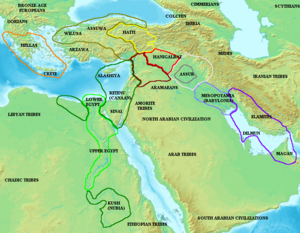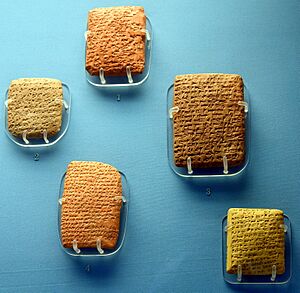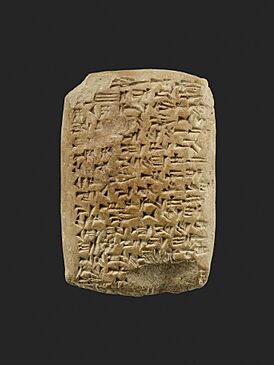Amarna letters facts for kids

The Amarna letters (pronounced "uh-MAR-nuh") are a collection of ancient messages written on clay tablets. They are like a super old email archive! Most of these letters are official messages between the Egyptian government and its leaders in places like Canaan and Amurru, or with kings from nearby countries. They were written during Egypt's New Kingdom period, about 3,400 years ago, over a span of less than 30 years.
These letters were found in Upper Egypt at a place called el-Amarna. This was the modern name for the ancient Egyptian capital city called Akhetaten, which was built by Pharaoh Akhenaten (who ruled around 1351–1334 BC).
What's really cool and unusual about the Amarna letters is that they aren't written in ancient Egyptian! Instead, they use cuneiform, which was the writing system from ancient Mesopotamia. Most of them are in a language called Akkadian, which was often mixed with Canaanite words. One very long letter, known as EA 24, was written in a language called Hurrian. It's the longest text we have in that language!
There are 382 known tablets and pieces. About 350 are letters, and the rest are school texts or stories. Most of them were published by a Norwegian expert named Jørgen Alexander Knudtzon in his book Die El-Amarna-Tafeln (1907 and 1915). Only 26 of these tablets were found by archaeologists in their original spot.
The Amarna letters are super important for understanding the Bible and ancient languages. They give us a peek into the culture and language of the Canaanite people from that time. Even though they are mostly in Akkadian, the people who wrote them often used words and phrases from their own languages, which were early forms of Proto-Canaanite. These languages later grew into Hebrew and Phoenician. So, these "Canaanite touches" in the letters help us learn about these languages hundreds of years before they fully developed.
Discovering the Letters
These clay tablets, mostly written in Akkadian (which was the main language for talking between different kingdoms back then), were first found around 1887. Local Egyptians secretly dug up most of them from the old city of Amarna and sold them. They had been stored in an ancient building that archaeologists now call the "Bureau of Correspondence of Pharaoh" – basically, the pharaoh's mailroom!
Once people figured out where the letters came from, archaeologists started looking for more. The first archaeologist to find more tablets was Flinders Petrie in 1891 and 1892. He found 21 pieces. Later, Émile Chassinat found two more in 1903. Since then, about 24 more tablets or pieces have been found in Egypt or identified in museum collections.
The first group of letters found by local Egyptians are now spread out in museums around the world. For example, over 200 are in Berlin, 99 are in London, and about 50 are in Cairo. Others are in Paris, Moscow, and Chicago.
This collection of letters gives us tons of information about the cultures, kingdoms, and important people from a time when we don't have many other written records. They include letters from the time of Pharaoh Amenhotep III and his son, Akhenaten.
Most of the tablets are diplomatic letters, meaning they are about how different rulers got along (or didn't!). They tell us a lot about Egypt's relationships with powerful places like Babylonia, Assyria, Syria, Canaan, and Alashiya (which is modern-day Cyprus). They also show how Egypt interacted with the Mitanni and the Hittites. These letters have been super helpful for figuring out the history and timeline of this ancient period.
For example, letters from the Babylonian king, Kadashman-Enlil I, help us know that Akhenaten ruled in the middle of the 14th century BC. The letters also mention a group called the Habiru. Some people wonder if they are connected to the Hebrews mentioned in the Bible, because the names sound similar and they lived in the same area. Other important rulers in the letters include Tushratta of Mitanni, Lib'ayu of Shechem, Abdi-Heba of Jerusalem, and the often-complaining king, Rib-Hadda, from Byblos. Rib-Hadda sent over 58 letters, constantly asking Egypt for military help! The letters show requests for help against Hittite invaders in the north and against the Habiru in the south.
A Letter Found in Tell Beth-Shean
In 1993, during an excavation, a small, damaged clay cylinder was found. It had "Amarna Cuneiform" writing on it and contained a letter that seems to be part of the Amarna collection. It was a message from someone named Tagi to Lab'aya, mentioning the King (Pharaoh).
What the Letters Talk About

The Amarna Letters are generally grouped by where they came from, moving in a rough circle:
- Letters from Babylonia (EA 001–014)
- Letters from Assyria (EA 015–016)
- Letters from Mitanni (EA 017–030)
- Letters from Arzawa (EA 031–032)
- Letters from Alashiya (EA 033–040)
- Letters from Hatti (EA 041–044)
- Letters from Syria/Lebanon/Canaan (EA 045–380+)
The letters from Syria, Lebanon, and Canaan are further divided:
- Syria (EA 045–067)
- Lebanon (EA 068–227), with many from Byblos (EA 68–140)
- Canaan (EA 227–380), mostly written in the Canaano-Akkadian language.
Akhenaten and Tushratta's Gold Problem
Early in his rule, Pharaoh Akhenaten had some disagreements with Tushratta, the king of Mitanni. Tushratta had been good friends with Akhenaten's father, Amenhotep III, especially when they were dealing with the Hittites.
In many letters, Tushratta complained that Akhenaten had sent him statues covered in gold, instead of statues made of solid gold. These statues were part of a "bride-price" – gifts Tushratta received when his daughter Tadukhepa married Amenhotep III, and then later Akhenaten.
One Amarna letter shows Tushratta's complaint to Akhenaten:
"I asked your father Mimmureya [Amenhotep III] for statues of solid gold. Your father said, 'Don't talk about just solid gold statues. I will give you ones made also of lapis lazuli. I will also give you much more gold and other goods beyond measure.' All my messengers who were in Egypt saw the gold for the statues with their own eyes. But my brother [Akhenaten] has not sent the solid gold statues your father was going to send. You have sent ones made of wood covered in gold. You also haven't sent me the goods your father was going to send, but you have greatly reduced them. Yet, I haven't failed my brother in anything. May my brother send me much gold. In my brother's country, gold is as common as dust. May my brother not cause me any trouble. May he send me much gold so that my brother can honor me with the gold and many goods."
This shows how kings used to exchange gifts and how important it was to keep promises, even about gold statues!
Interesting Phrases from the Letters
Some of the Amarna letters are like short poems. For example, EA 153, called "Ships on hold" from Abimilku of Tyre, is a short letter with only 20 lines. It has repeated phrases, like lines 6–8 and 9-11, which both end with "...before the troops of the king, my lord."
The Amarna letters often use certain standard phrases, but they also have some unique sayings or parables. Here are a few:
Bird in a Cage
- A bird in a cage (Trap)—This phrase was used by Rib-Hadda in his letters. He felt trapped in his city of Gubla (Byblos) and couldn't move freely.
"A brick may move.."
- A brick may move from under its partner, still I will not move from under the feet of the king, my lord.—This means "I will always be loyal to the king." It's found in letters EA 266, 292, and 296.
"For the lack of a cultivator.."
- "For the lack of a cultivator, my field is like a woman without a husband."—This phrase from Rib-Hadda's letter EA 75 means his land is neglected and unproductive without proper care.
"Hale like the Sun..."
- "And know that the King-(pharaoh) is hale like the Sun in the Sky. For his troops and his chariots in multitude all goes very well...."—This is a common way to praise the pharaoh, saying he is strong and everything is going well for him.
"I looked this way, and I looked..."
- "I looked this way, and I looked that way, and there was no light. Then I looked towards the king, my lord, and there was light."—This poetic phrase means that the writer felt lost or without hope until they turned to the pharaoh for help. It's in EA 266 and EA 296.
"May the Lady of Gubla.."
- "May the Lady of Gubla grant power to the king, my lord."—This phrase, found in Rib-Hadda's letters, is a prayer to a local goddess for the pharaoh's strength.
a pot held in pledge
- a pot held in pledge—This refers to something given as a guarantee for a debt. It's mentioned in EA 292.
7 times and 7 times again
- 7 times and 7 times—This means "over and over again" or "many times."
- 7 times plus 7—Similar to the above, meaning "many, many times."
I fall ... 7 times and 7 times..."on the back and on the stomach"
- I fall, at the feet, ... 7 times and 7 times, "on the back and on the stomach"—This is a very humble way of showing respect and submission to the pharaoh, meaning the writer bows down completely. It's in EA 316 and many other letters.
when an ant is struck..
- "...when an ant is pinched (struck), does it not fight back and bite the hand of the man that struck it?"—This phrase was used by Labayu in EA 252 to defend his actions, suggesting that even a small creature will fight back when attacked.
Images for kids
See also
- Abdi-Heba
- Amarna letters–localities and their rulers
- Ashur-uballit I
- Amarna Period
- Hittite inscriptions
- Labaya
- List of Amarna letters by size
- List of inscriptions in biblical archaeology
- Mari tablets
- Mutbaal
- Šuwardata
- Ugaritic texts







